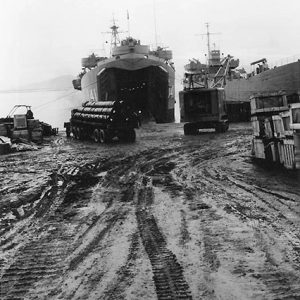calsfoundation@cals.org
USS Stone County (LST-1141)
The USS Stone County (LST-1141) was an LST-542–class tank landing ship built in 1945 that saw service in the Pacific after World War II and in the Korean and Vietnam wars. It was designated the USS Stone County on July 1, 1955, in honor of counties in Arkansas, Missouri, and Mississippi.
LST-1141 was one of a class of vessels—called Landing Ship, Tank—created to carry tanks, wheeled and tracked vehicles, artillery, construction equipment, and supplies during military operations along coastal areas. Called “Large Slow Targets” by their crews, they were designed as shallow-draft vessels; when carrying a 500-ton load, LST-1141 drew only three feet eleven inches forward and nine feet ten inches aft. They carried pontoons amidships that could be used to create causeways when they had to debark their cargos from deeper water, but they were also capable of dropping their forward ramps directly onto a beach.
LST-1141’s keel was laid down on January 22, 1945, by the Chicago Bridge and Iron Company of Seneca, Illinois, and christened by Gwendolyn K. Bartels and launched on April 18, 1945. LST-1141 weighed 1,625 tons, was 328 feet long and fifty feet wide, and could reach speeds of 11.6 knots. It carried a crew of thirteen officers and 104 men, and it could transport sixteen officers and 147 soldiers. LST-1141 was armed with two twin 40mm guns, four single 40mm guns, and twelve single 20mm guns. The vessel traveled down the Mississippi River to New Orleans, Louisiana, and was commissioned on May 9, 1945, under the command of Lieutenant E. N. Biggs.
The vessel moved to San Pedro, California, on July 6, and then departed for Hawaii, arriving at Pearl Harbor on July 23. LST-1141 set sail for the Marianas on August 15 and then moved to Tokyo in early October after stops in Guam and Saipan. It operated in the Marianas before sailing to San Francisco, California, on December 22, 1945. After activities along the West Coast until May 1946, the vessel sailed to China, arriving at Shanghai on June 12. It primarily engaged in operations along the Chinese coast until sailing back to San Francisco on June 4, 1949. It was decommissioned on August 24, 1949, and placed in the Pacific Reserve Fleet at San Diego.
As the Korean War began in June 1950, LST-1141 was recommissioned on November 3 and sailed for Japan on March 21, 1951, with a load of cargo. From May 1951 until returning to the United States the following spring, the LST performed amphibious training exercises and ran supplies between Japan and Korea. After operations along the West Coast of the United States from March 1952 to January 1953, LST-1141 returned to Yokosuka, Japan, in late February 1953, and resumed the routine of supply runs until November, though it did participate in Operation Big Switch, the final prisoner exchange at the end of the Korean conflict.
LST-1141 worked along the West Coast during 1954, then returned to the Far East between January and April 1955. On July 1, 1955, it was designated the USS Stone County, and the vessel spent the rest of 1955 training U.S. Marines in amphibious landings in California. The Stone County had numerous deployments to the Pacific interspersed with periods of training operations in the United States between 1956 and spring 1965.
The USS Stone County entered the Vietnam War when it delivered elements of Battery A, Second Light Antiaircraft Missile Battalion at Chu Lai on September 12, 1965. After an overhaul in the United States, it returned to Chu Lai on June 17, 1966, to transport marines of the Ninth Engineering Battalion. It spent the bulk of rest of the year delivering supplies between Danang and Chu Lai and other operations in Vietnam before returning to San Diego, California, on December 2. The Stone County returned to Danang on April 25, 1968, supporting military efforts in Vietnam before heading back to San Diego on December 31.
The USS Stone County left the United States for Guam in October 1969 and was transferred under lease to the Royal Thai Navy under the Military Assistance Program on March 12, 1970, beginning service as the Lanta (LST-4). It was sold outright to the Thai navy and struck from the U.S. Navy list on August 15, 1973, having won four battle stars each for operations in Korea and Vietnam. The Royal Thai Navy re-designated the Lanta as LST-714 sometime between 1995 and 1997 and decommissioned the vessel sometime after 1999. The vessel then began serving as part of a museum site at Krabi, Thailand.
For additional information:
“LST 1141 Stone County.” https://www.hazegray.org/danfs/amphib/lst1141.txt (accessed January 13, 2018).
Rottman, Gordon L. Landing Ship, Tank (LST) 1942–2002. Oxford, UK: Osprey Publishing Co., 2005.
“USS Stone County (LST-1041).” NavSource Online. https://www.history.navy.mil/research/histories/ship-histories/danfs/l/lst-1141.html (accessed January 13, 2018).
Mark K. Christ
Little Rock, Arkansas
 Military
Military Stone County
Stone County World War II through the Faubus Era, 1941 through 1967
World War II through the Faubus Era, 1941 through 1967 USS Stone County (LST-1141)
USS Stone County (LST-1141)  USS Stone County (LST-1141)
USS Stone County (LST-1141) 




Was deployed on this ship during the “Cuba Crisis” K-4-11, self-propelled 155 howitzers, with tactical nukes. We went through a typhoon for 14 hours causing the bow to go underwater and the propellers to come out of the water with each wave! Myself and only three other Marines were the only Marines aboard not seasick. Most of the Navy crew were also seasick. Cook told us we could eat officer’s food because they were all seasick. Once, I went out on the main deck during the typhoon and got into a 5-ton truck to watch the storm. Waves were coming over the trucks and we had to run hand-operated windshield wipers to see what was happening. On the way back we found about 20 feet of handrails missing and reported it to the superior officer. They called for a head count to make sure everyone was still there. James L. Frederic, Fire Direction Control